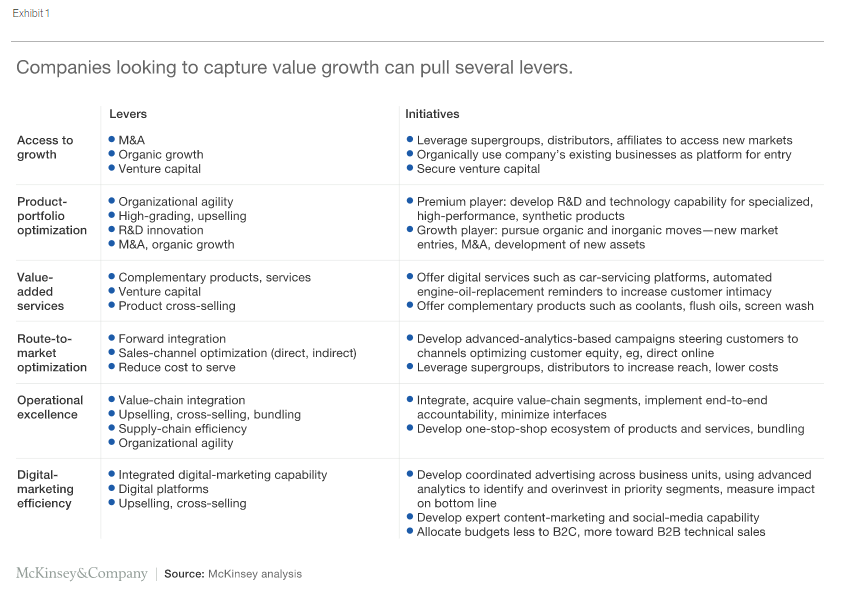By Alvaro Bau, Giovanni Bruni, Luqman Hussin, Dieter Kiewell, Bijan Kohler, and Richard Verit
Given the threat of disruptive change in the lubes market, companies need to plan competitive strategies quickly and carefully, with a focus on extending their offerings beyond the core products.
Lubricants remain an attractive—but also challenging—business in the short term. Value growth is not evenly spread, and suppliers will need to design strategies that ensure access to growth areas (Exhibit 1).

Most value growth from 2025 to 2035 is expected to come from rising margins, which are largely dependent on a switch to branded, synthetic lubricants in the road-transport sector. It would be wise to focus on the development of these products—especially in the fast-growing emerging markets in Africa, Asia, and Latin America.
To optimize portfolios, premium players should emphasize R&D and improved technology capability for specialized, high-performance, or synthetic products. To ensure volume growth, companies may wish to pursue new market entries, M&A, and development of new assets. This could involve leveraging distributors or affiliates to help penetrate new markets; alternatively, the company’s existing businesses may be the best platform for entry.
Preparing for the challenges
The strategy also needs to mitigate the impact of disruptive change (Exhibit 2). For example, companies can hedge against faster battery-cost reduction by improving access to non-battery electric-vehicle (EV) growth markets and by developing specific EV products, such as specialized battery coolants.

To meet the rising B2B challenge, companies will need to depend increasingly on a lubricants-plus offer, involving value-adding services and greater customer engagement that build customer loyalty and intimacy (Exhibit 3). To make sure this is achieved efficiently, companies must optimize product portfolios and routes to market, move forward with sales-channel integration, and hone digital-marketing skills to engage buyers.

The sort of added services that could be offered include remote Internet of Things (IoT)–enabled real-time monitoring of equipment and stock levels, such as that used by Morris Lubricants and Petasense. This improves maintenance efficiency and enables vendor-managed stock optimization while helping to increase customer intimacy.
Another service is real-time used-oil analysis, which involves a sitewide fluid-management system that uses on-site sensors to analyze used-lube-oil samples. The results can be compared with a used-oil database to optimize lubricant change intervals and product selection. To offer such a service, companies must develop or obtain sensor technology and the artificial-intelligence and advanced-analytics solutions needed to analyze and compare samples successfully.
Full market commoditization can be countered to some extent by acquisitions to improve scale economies, as well as by raising operational excellence to secure margins.
Early movers
Companies need to act fast, as the competition is already investing in technology and assets to position themselves better for the value pools of the future. For example, to access growth in new markets, FUCHS has acquired seven companies—which have cumulative revenues of more than $350 million—since 2010. China’s Sinopec is entering the South African market through the acquisition of a Chevron lubes-blending plant, while Shell has built high-capacity blending and grease plants in Indonesia and Singapore to support its Asian growth strategy.
Examples of developing optimum routes to market include Gulf Oil International’s channel strategy, which realized 30 percent volume growth by building an Indian distribution network. And Malaysia’s Petroliam Nasional Berhad (PETRONAS) recently targeted 20 percent market-share growth via partnerships with nine franchisees in East Malaysia, supplying them with products and tools.
In addition to entering new geographical markets, partnerships and acquisitions can achieve improved product offerings, as illustrated by FUCHS’s purchase of Ultrachem and industrial specialties intellectual property. Another option for today’s suppliers is to raise quality by using gas-to-liquids (GTL) plants, which produce very pure, proprietary GTL base oils.
Recent moves in value-added B2B services include Peloton Technology’s fuel-efficiency and road-safety improvements, using wirelessly connected trucks that form an aerodynamic platoon. Similarly, car-management system Zubie has developed a plug-in that provides real-time data on performance, maintenance status, and safety. And in the marine market, GreenSteam’s fuel-saving system for ships collects sensor readings to optimize trim and draft, minimizing resistance.
To make the most of the value opportunities that present themselves in the lubes market over the next ten to 15 years, manufacturers and suppliers must position their businesses carefully, focusing on markets with the most value-growth potential and developing more defensive strategies elsewhere. There is a big potential prize in a 44 percent value-pool expansion, but this will only be realized if companies prepare strategically for disruptive threats to profitability—in particular, guarding against the threat of commoditization by designing distinct product offerings with added value.

